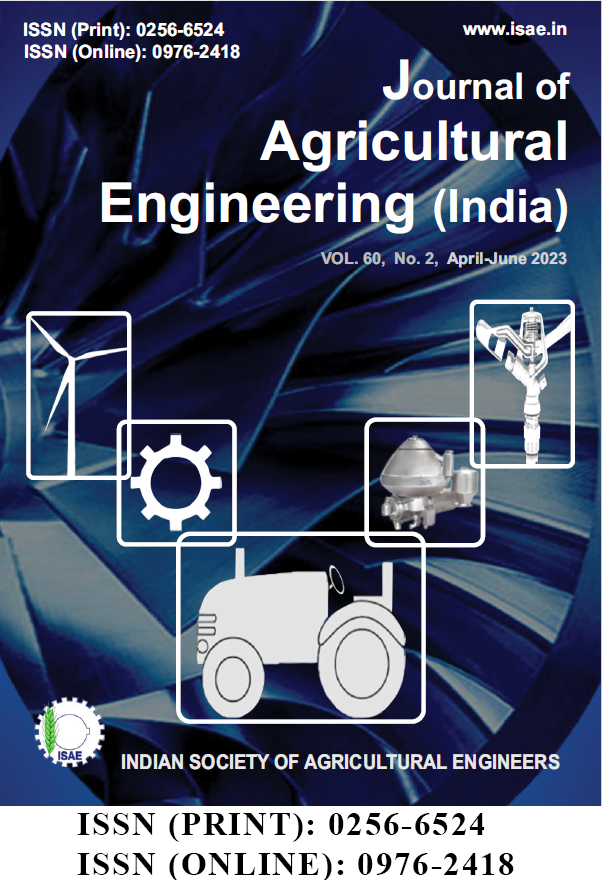Design and Development of Throttle Valve-based Hydrodynamic Cavitator for Food
DOI:
https://doi.org/10.52151/jae2023602.1806Keywords:
Hydrodynamic cavitation, iodine liberation, super-cavitation, throttle valveAbstract
Hydrodynamic cavitation is an emerging non-thermal technology in food sector. The existing methods are venturi meter, orifice meter, and high-speed homogenizer. The former two are economic, but susceptible to clogging as cavitation occurs close to the walls. High volumetric flow rate causes flow instability and super-cavitation that limit the use of venturi meter. The latter device performs well, but is expensive. The present research was undertaken for design and development of a throttle valve-based hydrodynamic cavitator to overcome above issues. The throttle valve for creating cavitation was fixed on the suction side of the pump. To avoid cavitation and to fully recover the downstream pressure, the minimum length between throttle valve and pump was found to be 1.25 m. Iodine liberation was studied as a function of cavitation number for performance evauation of the hydrodynamic reactor. It increased increased when cavitation number decreased up to 0.42, and super-cavitation occurred beyond that value.
References
Asaithambi N; Singha P; Dwivedi M; Singh S K. 2019. Hydrodynamic cavitation and its application in food and beverage industry: A review. J. Food Process. Eng., 42(5), e13144. http://dx.doi.org/10.1111/jfpe.13144
Badve M P; Alpar T; Pandit A B; Gogate P R; Csoka L. 2015. Modeling the shear rate and pressure drop in a hydrodynamic cavitation reactor with experimental validation based on KI decomposition studies. Ultrason. Sonochem., 22, 272-277. http://dx.doi.org/10.1016/j.ultsonch.2014.05.017
Badve M P; Gogate P R; Pandit A B; Csoka L. 2014. Hydrodynamic cavitation as a novel approach for delignification of wheat straw for paper manufacturing. Ultrason. Sonochem., 21(1), 162-168. http://dx.doi.org/10.1016/j.ultsonch.2013.07.006
Carpenter J; Badve M; Rajoriya S; George S; Saharan V K; Pandit A B. 2017. Hydrodynamic cavitation: an emerging technology for the intensification of various chemical and physical processes in a chemical process industry. Rev. Chem. Eng., 33(5), 433-468. http://dx.doi.org/10.1515/revce-2016-0032
Das S; Bhat A P; Gogate P R. 2021. Degradation of dyes using hydrodynamic cavitation: Process overview and cost estimation. J. Water Process. Eng., 42, e102126. http://dx.doi.org/10.1016/j.jwpe.2021.102126
Ferrari A. 2017. Fluid dynamics of acoustic and hydrodynamic cavitation in hydraulic power systems. Proc. R. Soc. A, 473(279), 20160345. http://dx.doi.org/10.1098/rspa.2016.0345
Kim H; Koo B; Lee S; Yoon J Y. 2019. Experimental study of cavitation intensity using a novel hydrodynamic cavitation reactor. J. Mech. Sci. Technol., 33(9), 4303- 4310. http://dx.doi.org/10.1007/s12206-019-0826-8
Li M; Bussonnière A; Bronson M; Xu Z; Liu Q. 2019. Study of venturi tube geometry on the hydrodynamic cavitation for the generation of microbubbles. Miner. Eng., 132, 268-274. http://dx.doi.org/10.1016/j.mineng.2018.11.001
Lohani U C; Muthukumarappan K; Meletharayil G H. 2016. Application of hydrodynamic cavitation to improve antioxidant activity in sorghum flour and apple pomace. Food Bioprod. Process., 100, 335-343. http://dx.doi.org/10.1016/j.fbp.2016.08.005
Michael A M. 2015. Irrigation Theory and Practice. Vikas Publishing House Pvt. Ltd., New Delhi, Second revised enlarged edition, pp: 768. ISBN: 9788125918677
Modi P N; Seth S M. 2017. Hydraulics and Fluid Mechanics including Hydraulic Machines (in SI units). Rajso- The future of greener extraction method: A review on the extraction of natural products and process intensification mechanism and perspectives. Appl. Sci., 9(4), 766. https://doi.org/10.3390/app9040766
Panda D; Sharan V K; Manickam S. 2020. Controlled hydrodynamic cavitation: A review of recent advances and perspectives for greener processing. Process., 8(2), 220. https://doi.org/10.3390/pr8020220
Soe T M; Myo L. 2018. Impeller design of centrifugal blower for 40 kW wood chips gasifier. Int. J. Sci. Res. Publ., 8 (7), 89-95. http://dx.doi.org/10.29322/IJSRP.8.7.2018.p7915
Sun X; You W; Wu Y; Tao Y; Yoon J Y; Zhang X; Xuan X. 2022. Hydrodynamic cavitation: A novel non-thermal liquid food processing technology. Front. Nutr., 9, e843808. http://dx.doi.org/10.3389/fnut.2022.843808
Wu B; Hu Y; Wang X; Yan X. 2020. Experimental and CFD investigations of choked cavitation characteristics of the gap flow in the valve lintel of navigation locks. J. Hydrdyn., 32, 997-1008. https://doi.org/10.1007/s42241-020-0065-6
Wu Z; Ferreira D F; Crudo D; Bosco V; Stevanato L; Costale A; Cravotto G. 2019. Plant and biomass extraction and valorisation under hydrodynamic cavitation. Process., 7(12), 965. http://dx.doi.org/10.3390/pr7120965
Wu Z; Yuste-Cordoba F J; Cintas P; Wu Z; Boffa L; Mantegna S; Cravotto G. 2018. Effects of ultrasonic and hydrodynamic cavitation on the treatment of cork wastewater by flocculation and Fenton processes. Ultrason. Sonochem., 40 (B), 3-8. https://doi.org/10.1016/j.ultsonch.2017.04.016
Zakeralhoseini S; Schiffmann J. 2023. The influence of splitter blades and meridional profiles on the performance of small-scale turbopumps for ORC applications; analysis, neural network modeling and optimization. Therm. Sci. Eng. Process., 39, 101734. https://doi.org/10.1016/j.tsep.2023.101734
Zhang K; Dong Z; Yao R. 2018. Pressure characteristics of hydrodynamic cavitation reactor due to the combination of venturi tubes with multi-orifice plates. J. Hydrody., 30, 514-521. https://doi.org/10.1007/s42241-018-0056-z














